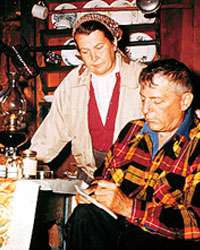Valentina Pavlovna Wasson
Valentina Pavlovna (Guercken) Wasson (1901–1958) was a Russian-American pediatrician, ethnomycologist and author. She was involved in the introduction of psychoactive mushrooms to a wide audience in the United States.
Valentina Pavlovna Wasson | |
|---|---|
 Valentina Pavlovna Wasson with R. Gordon Wasson | |
| Born | 1901 |
| Cause of death | Cancer |
| Nationality | Russian |
| Citizenship | American |
| Scientific career | |
| Fields | Pediatrician Ethnomycologist |
Life
Valentina Pavlovna Guercken was born in 1901 in Russia. When she was a baby, her family immigrated to the United States to escape the Russian Revolution. She grew up to become a pediatrician.[1]
In 1926, she married R. Gordon Wasson. The couple married in London, England. The couple went to the Catskill Mountains for their honeymoon in 1927. Wasson found edible mushrooms one day, but her new husband refused to eat them.[1] They found that their diverging attitudes towards the plant was well documented in the folkloric traditions of Europe. They hypothesized that the peoples of the world could be separated into “mycophiles” and “mycophobes" — for which they coined the term — with the Slavs standing as the clearest example of the former, and the Anglo-Saxons of the latter. This led them to suspect some deep-seated and ancient taboo against the profane use of a religious sacrament, still practiced, as they discovered.[2]
The couple described themselves as "ethnomycologists" — one who studies the cultural use of mushrooms and would pursue the study of mushrooms, particularly psychedelic mushrooms, for their 30 plus year career together.[1]
Discovery and popularization of psychedelic mushrooms
In 1952 the poet Robert Graves sent the Wassons an article that mentioned the discovery in 1938. by Richard Evans Schultes, of the survival of the use of intoxicating mushrooms among the Indians in Mexico. Immediately Gordon Wasson telephoned Schultes at Harvard; the confirmation and encouragement he received focused his attention on Mexico.
Tina and Gordon Wasson organized yearly research expeditions to the remote mountain villages of the monolingual Mazatec Indians of Oaxaca, Mexico, and in 1955 were the first outsiders in modern times to participate in the midnight rites of the cult of the sacred mushroom.
Beginning in 1953, the Wassons travelled to Mexico, in the Mazatec village Huautla de Jiménez, to research the traditional use of mushrooms there.[3] They received especially valuable information from an American missionary who had been active there for many years, Eunice V. Pike, member of the Wycliffe Bible Translators. Thanks to her knowledge of the native language and her ministerial association with the inhabitants, Pike had information about the significance of the magic mushrooms that nobody else possessed. During several lengthy sojourns in Huautla and environs, the Wassons were able to study the present use of the mushrooms in detail and compare it with the descriptions in the old chronicles. This showed that the belief in the "sacred mushrooms" was still prevalent in that region. However, the Indians kept their beliefs a secret from strangers. It took great tact and skill, therefore, to gain the confidence of the indigenous population and to receive insight into this secret domain.[4]
They announced their discovery in 1957 in their jointly written book Mushrooms Russia and History. The Wassons' first book, had begun as a cookbook by Wasson and the Wassons' Russian cook, Florence James.[2] Concurrently, a lengthy illustrated article by R. Gordon in Life Magazine,[5] May 13, 1957, on the Mexican mushroom veladas (sessions) with Maria Sabina gave rise to large numbers of individuals searching the wooded mountain regions of Mexico to discover for themselves the mushrooms with visionary powers.
Wasson's account of this experience was published in This Week on May 19, 1957,[6] six days after her husband's famous piece was published in Life magazine. In this article, Valentian becomes one of the first to suggest that psychedelic mushrooms might be used as a psychotherapeutic agent. She expressed the opinion that if the active agent could be isolated and a sufficient supply assured, it might become a vital tool in the study of psychic processes. She also stated that as the drug would become better known, medical uses would be found for it, perhaps in the treatment of alcoholism, narcotic addiction, mental disorders, and terminal diseases associated with severe pain. Several years later a team of researchers working in Baltimore independently tested the validity of her unusual vision.[7] Her suggestion that transition to death could be eased by a dosage of LSD was followed by Aldous Huxley.[2]
Wasson died of cancer in 1958 at the age of 59.
Following Wasson's death, Gordon continued their research, working closely with Roger Heim, a French mycologist and the director of the Museum National d’Histoire Naturelle, who had accompanied the Wassons on several expeditions to Mexico[8]
Bibliography
- Wasson, Valentina Pavlovna (1939). The chosen baby. New York: J.B. Lippincott.
- Wasson, Valentina Pavlovna; Wasson, R. Gordon (1957). Mushrooms: Russia and History. Pantheon Books.
- "I Ate the Sacred Mushroom". THIS WEEK Magazine. May 19, 1957.
Recordings
- Maria Sabína - Mushroom Ceremony Of The Mazatec Indians Of Mexico. Recorded by V. P. & R. G. Wasson in Huautla de Jiménez, in the Mazatec Mountains in the northern corner of the State of Oaxaca, July 21, 1956[9]
References
- "Erowid Valentina Wasson Vault". Erowid.org. Retrieved 25 November 2018.
- Brown, Christopher (25 November 1987). "R. Gordon Wasson, 22 September 1898-23 December 1986". Economic Botany. 41 (4): 469–473. doi:10.1007/BF02908138. JSTOR 4255015.
- "Albert Hofmann's My Problem Child". Hallucinogens.org.
- Tarinas, Joaquim. "ROBERT GORDON WASSON Seeking the Magic Mushroom". Imaginaria.org.
- Halifax, Stanislav Grof and Joan. "The History of Psychedelic Therapy with the Dying". Psychedelic-library.org.
- "Botany Libraries Archives, R. Gordon Wasson Archives". Botlib.huh.harvard.edu.
- "Mushroom Ceremony of the Mazatec Indians of Mexico". Smithsonian Folkways Recordings.